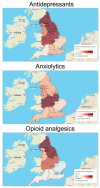Environmental Occurrence and Predicted Pharmacological Risk to Freshwater Fish of over 200 Neuroactive Pharmaceuticals in Widespread Use
- PMID: 35622646
- PMCID: PMC9143194
- DOI: 10.3390/toxics10050233
Environmental Occurrence and Predicted Pharmacological Risk to Freshwater Fish of over 200 Neuroactive Pharmaceuticals in Widespread Use
Abstract
There is a growing concern that neuroactive chemicals released into the environment can perturb wildlife behaviour. Among these chemicals, pharmaceuticals such as antidepressants and anxiolytics have been receiving increasing attention, as they are specifically prescribed to modify behavioural responses. Many laboratory studies have demonstrated that some of these compounds can affect various aspects of the behaviour of a range of aquatic organisms; however, these investigations are focused on a very small set of neuroactive pharmaceuticals, and they often consider one compound at a time. In this study, to better understand the environmental and toxicological dimension of the problem, we considered all pharmaceuticals explicitly intended to modulate the central nervous system (CNS), and we hypothesised that these compounds have higher probability of perturbing animal behaviour. Based on this hypothesis, we used the classification of pharmaceuticals provided by the British National Formulary (based on their clinical applications) and identified 210 different CNS-acting pharmaceuticals prescribed in the UK to treat a variety of CNS-related conditions, including mental health and sleep disorders, dementia, epilepsy, nausea, and pain. The analysis of existing databases revealed that 84 of these compounds were already detected in surface waters worldwide. Using a biological read-across approach based on the extrapolation of clinical data, we predicted that the concentration of 32 of these neuroactive pharmaceuticals in surface waters in England may be high enough to elicit pharmacological effects in wild fish. The ecotoxicological effects of the vast majority of these compounds are currently uncharacterised. Overall, these results highlight the importance of addressing this environmental challenge from a mixture toxicology and systems perspective. The knowledge platform developed in the present study can guide future region-specific prioritisation efforts, inform the design of mixture studies, and foster interdisciplinary efforts aimed at identifying novel approaches to predict and interpret the ecological implications of chemical-induced behaviour disruption.
Keywords: behaviour; ecotoxicology; environmental risk assessment; fish; mixture toxicology; pharmaceuticals in the environment; pollution; predictive toxicology.
Conflict of interest statement
The authors declare no conflict of interest.
Figures




References
Grants and funding
LinkOut - more resources
Full Text Sources

